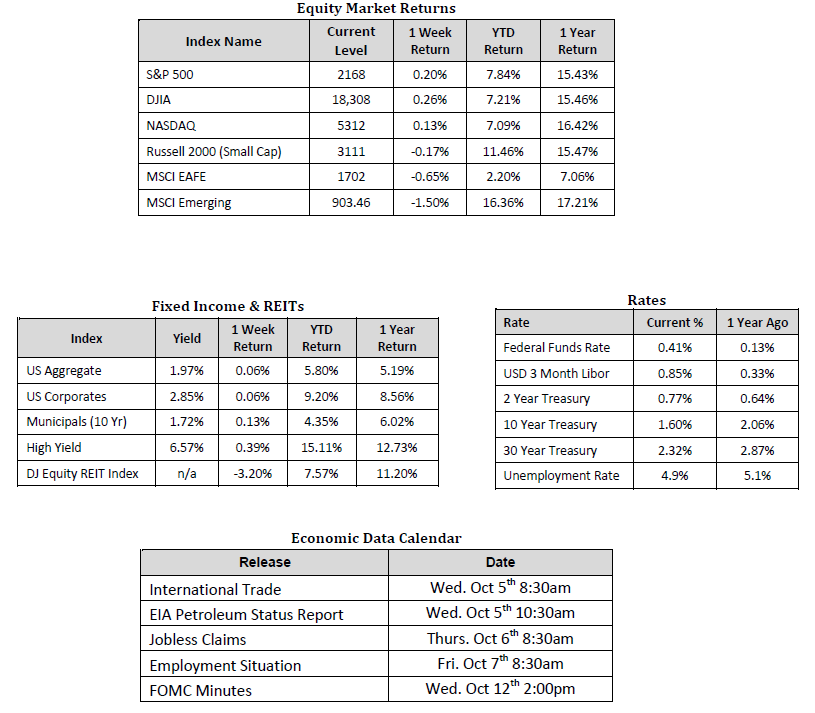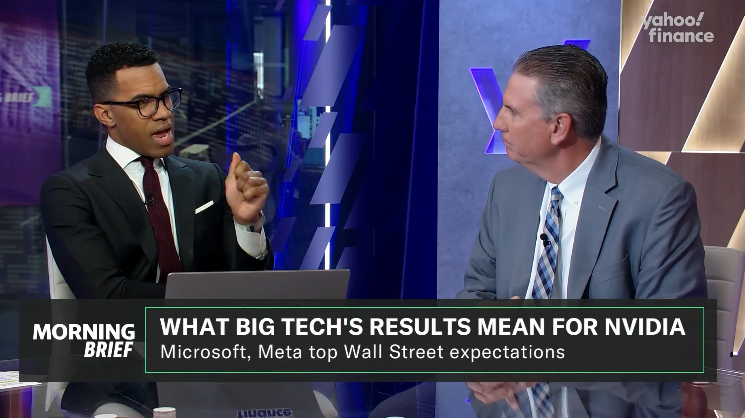
A Relatively Quiet but Profitable Third Quarter
Market Overview
Sources: Equity Market and Fixed Income returns are from JP Morgan as of 09/30/16. REIT, Rates and Economic Calendar Data from Bloomberg as of 10/03/16.
Happening Now
U.S. stocks1 gained 0.2% last week, developed international markets2 declined 0.65%, and emerging markets3 fell 1.5%. Headlines were dominated by a potential OPEC deal which propelled oil prices 7.7% higher, closing the week at $48.24 for a barrel of WTI Crude. The energy sector was a direct beneficiary of higher oil prices and was the best performing sector of the stock market during September with a 3.1% gain for the month. In fact, energy is now the best performing sector this year, up 18.7% through Friday’s close. While higher oil prices propped up the stock market, Deutsche Bank’s plummeting stock price led to concerns that partially offset the earlier gains. Despite the media drawing similarities to 2008, the majority of analysts believe that Deutsche Bank, while a troubled institution for sure, is not a catalyst for a wide spread financial crises. Comparisons being drawn between 2008 and Deutsche Bank’s current predicament are not well founded and made based more on convenience than on facts.
The third quarter concluded last week with the S&P 500 Index gaining 3.9% for the three month period, the most of any quarter so far this year. International developed markets2 advanced 6.5% while emerging markets3 continued to shine with a 9.2% gain from July through September. The third quarter started with rapid gains in stocks prices as concerns over Brexit faded. Following the 3.7% gain during the month of July, stock prices settled into a lull, moving no more than 1% for over 40 trading days.
An eventful stage is set for the fourth quarter with U.S. elections, interest rates, oil prices and corporate earnings all drawing investor attention. While each of these has the potential to move the market and create opportunities, they can also serve as a distraction. Investors need to remain focused on their long term objectives in order to avoid making short term decisions that could cause their portfolio to drift from the ideal mix of securities.
1U.S. stocks measured by the S&P 500 Index. 2International developed markets are represented by the MSCI ACW Index. 3Emerging markets represented by the MSCI EM Index.
Important Information and Disclaimers
Disclosures: Hennion & Walsh is the sponsor of SmartTrust® Unit Investment Trusts (UITs). For more information on SmartTrust® UITs, please visit www.smarttrustuit.com. The overview above is for informational purposes and is not an offer to sell or a solicitation of an offer to buy any SmartTrust® UITs. Investors should consider the Trust’s investment objective, risks, charges and expenses carefully before investing. The prospectus contains this and other information relevant to an investment in the Trust and investors should read the prospectus carefully before they invest.
Investing in foreign securities presents certain risks not associated with domestic investments, such as currency fluctuation, political and economic instability, and different accounting standards. This may result in greater share price volatility. These risks are heightened in emerging markets.
There are special risks associated with an investment in real estate, including credit risk, interest rate fluctuations and the impact of varied economic conditions. Distributions from REIT investments are taxed at the owner’s tax bracket.
The prices of small company and mid cap stocks are generally more volatile than large company stocks. They often involve higher risks because smaller companies may lack the management expertise, financial resources, product diversification and competitive strengths to endure adverse economic conditions.
Investing in commodities is not suitable for all investors. Exposure to the commodities markets may subject an investment to greater share price volatility than an investment in traditional equity or debt securities. Investments in commodities may be affected by changes in overall market movements, commodity index volatility, changes in interest rates or factors affecting a particular industry or commodity.
Products that invest in commodities may employ more complex strategies which may expose investors to additional risks.
Investing in fixed income securities involves certain risks such as market risk if sold prior to maturity and credit risk especially if investing in high yield bonds, which have lower ratings and are subject to greater volatility. All fixed income investments may be worth less than original cost upon redemption or maturity. Bond Prices fluctuate inversely to changes in interest rates. Therefore, a general rise in interest rates can result in the decline of the value of your investment.
Definitions
MSCI- EAFE: The Morgan Stanley Capital International Europe, Australasia and Far East Index, a free float-adjusted market capitalization index that is designed to measure developed-market equity performance, excluding the United States and Canada.
MSCI-Emerging Markets: The Morgan Stanley Capital International Emerging Market Index, is a free float-adjusted market capitalization index that is designed to measure the performance of global emerging markets of about 25 emerging economies.
Russell 3000: The Russell 3000 measures the performance of the 3000 largest US companies based on total market capitalization and represents about 98% of the investible US Equity market.
ML BOFA US Corp Mstr [Merill Lynch US Corporate Master]: The Merrill Lynch Corporate Master Market Index is a statistical composite tracking the performance of the entire US corporate bond market over time.
ML Muni Master [Merill Lynch US Corporate Master]: The Merrill Lynch Municipal Bond Master Index is a broad measure of the municipal fixed income market.
Investors cannot directly purchase any index.
LIBOR, London Interbank Offered Rate, is the rate of interest at which banks offer to lend money to one another in the wholesale money markets in London.
The Dow Jones Industrial Average is an unweighted index of 30 “blue-chip” industrial U.S. stocks.
The S&P Midcap 400 Index is a capitalization-weighted index measuring the performance of the mid-range sector of the U.S. stock market, and represents approximately 7% of the total market value of U.S. equities. Companies in the Index fall between S&P 500 Index and the S&P SmallCap 600 Index in size: between $1-4 billion.
DJ Equity REIT Index represents all publicly traded real estate investment trusts in the Dow Jones U.S. stock universe classified as Equity REITs according to the S&P Dow Jones Indices REIT Industry Classification Hierarchy. These companies are REITSs that primarily own and operate income-producing real estate.




